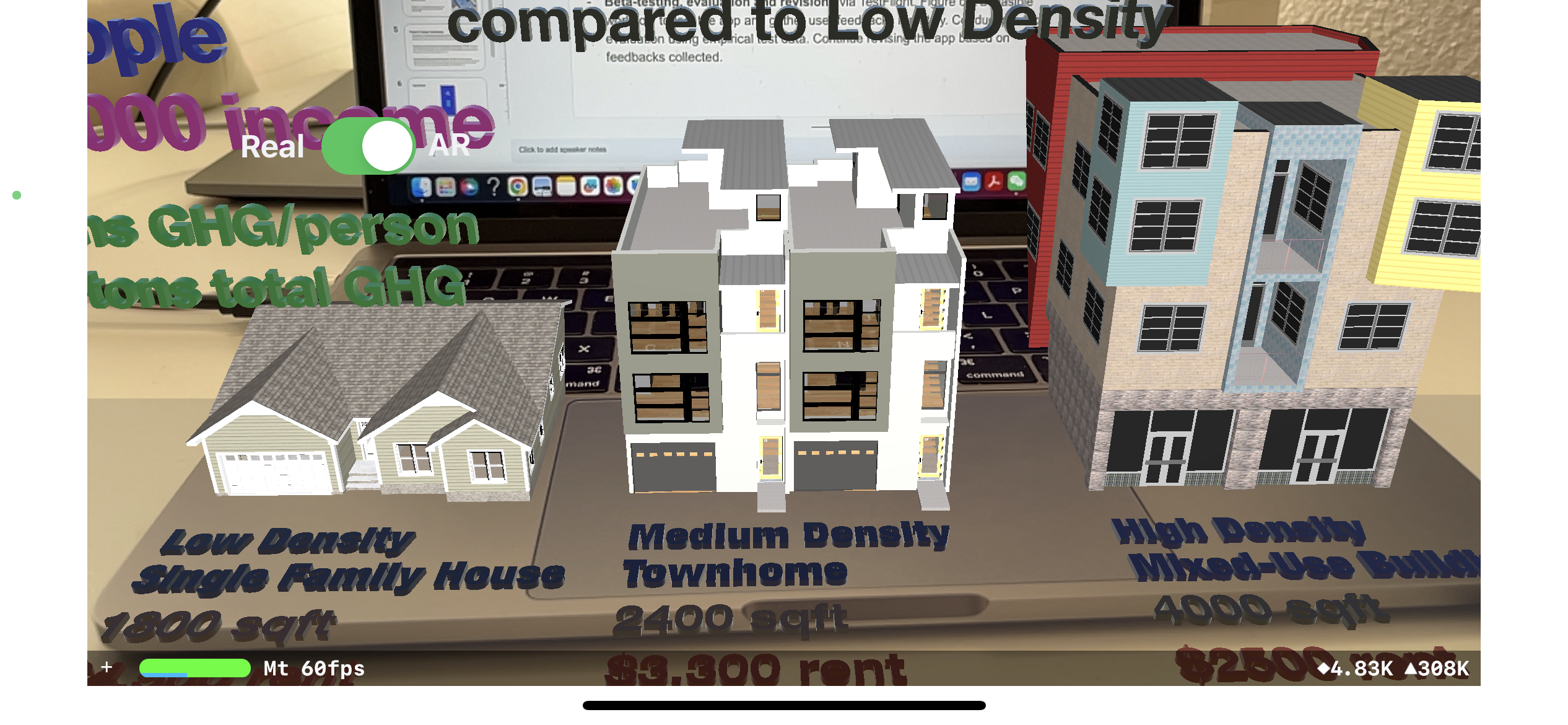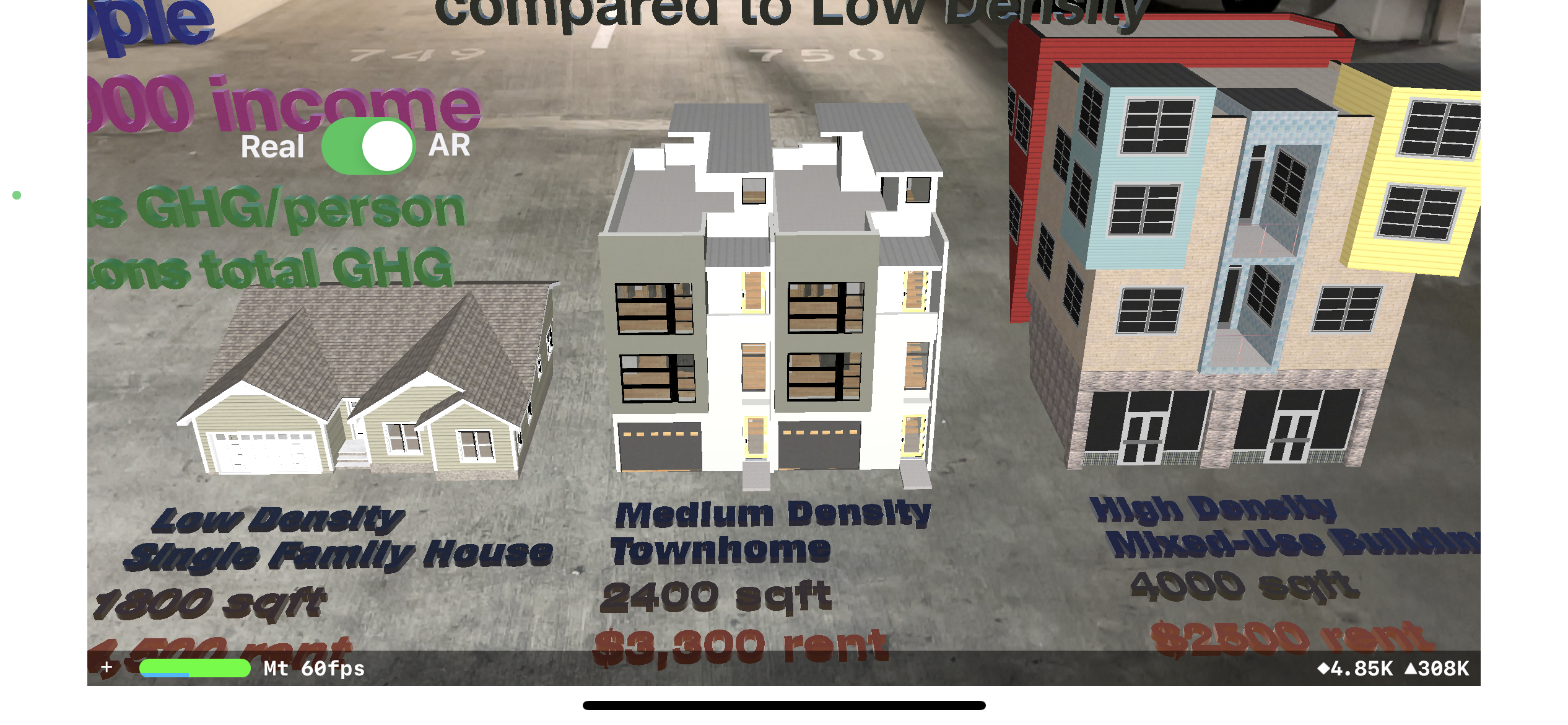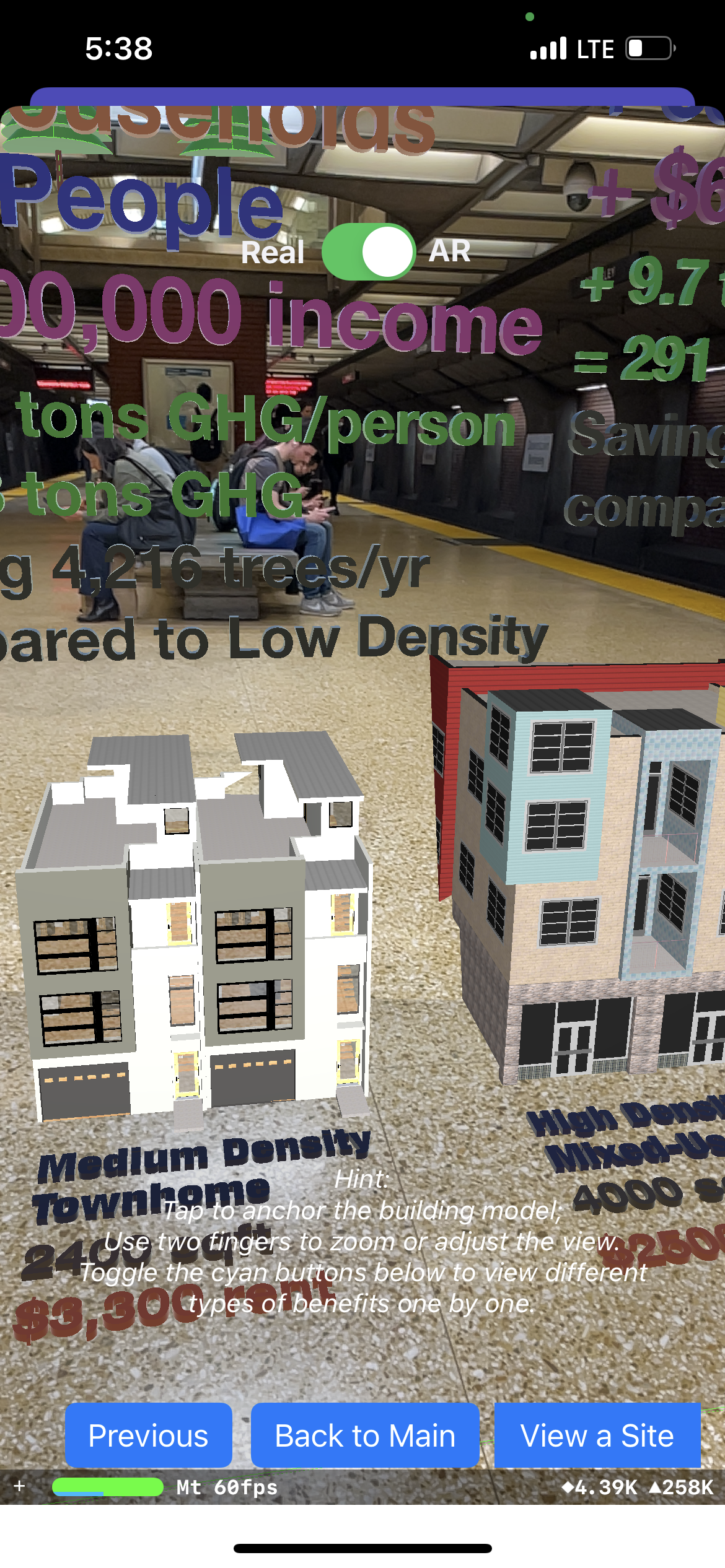ARYIMBY: an Augmented Reality App to promote sustainable urban development
This post introduces an independently developed Augmented Reality iOS mobile app that aims to educate and promote the knowledge of high density urban development in cities. Feel free to check out a video demo showcasing the final app here. Also, you’re more than welcome to reach out to participate the beta-testing via TestFlight!
![]()
Project Background: Misconception and Ignorance as Barriers to Higher Density Development in an Age of Escalating Housing Crisis
In this projecIn 2022, over 57% of world population live in urban areas. In North American, this rate is over 80% (Statista, 2022). As more and more people are migrating to cities and towns across many emerging and developing countries, issues such as rocketing housing costs, congested commuting traffic and rising green house gas emissions are posing significant threats to people’s quality of life. In particular, escalating housing crises are emerging in many US cities, where huge housing demands are not met by the current housing stock provided through a predominantly low density development pattern. The subsequent rising housing costs are becoming real burdens for new residents in cities.
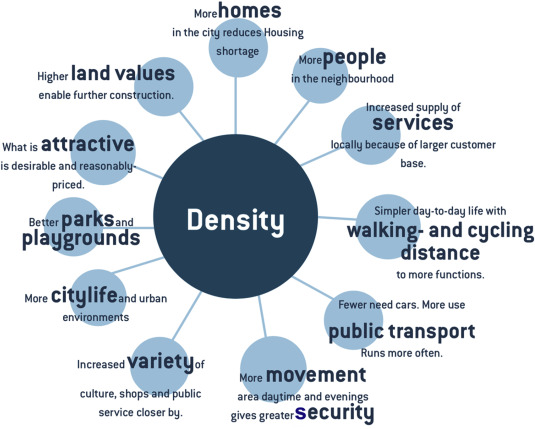 While urban density might easily be blamed as a simple cause of the above mentioned issues, higher density development is actually one of the few reliable solutions for cities to embark a sustainable development trajectory with more efficient land and building uses, shorter commuter trips, and broader urban amenities such as walkability, city vitality and safer streets. However, significant local opposition, which is often characterized as “Not in my backyard” (NIMBY) voices, exists in many places. More often than not, these local opponents have misconceptions about higher density developments and don’t necessarily acknowledge its indirect benefits, thus they can act aggressively and significantly delay the progression of the new development, stagnizing the realization of planned building activities (Whittemore et al., 2018). Watch an introductory video here.
While urban density might easily be blamed as a simple cause of the above mentioned issues, higher density development is actually one of the few reliable solutions for cities to embark a sustainable development trajectory with more efficient land and building uses, shorter commuter trips, and broader urban amenities such as walkability, city vitality and safer streets. However, significant local opposition, which is often characterized as “Not in my backyard” (NIMBY) voices, exists in many places. More often than not, these local opponents have misconceptions about higher density developments and don’t necessarily acknowledge its indirect benefits, thus they can act aggressively and significantly delay the progression of the new development, stagnizing the realization of planned building activities (Whittemore et al., 2018). Watch an introductory video here.
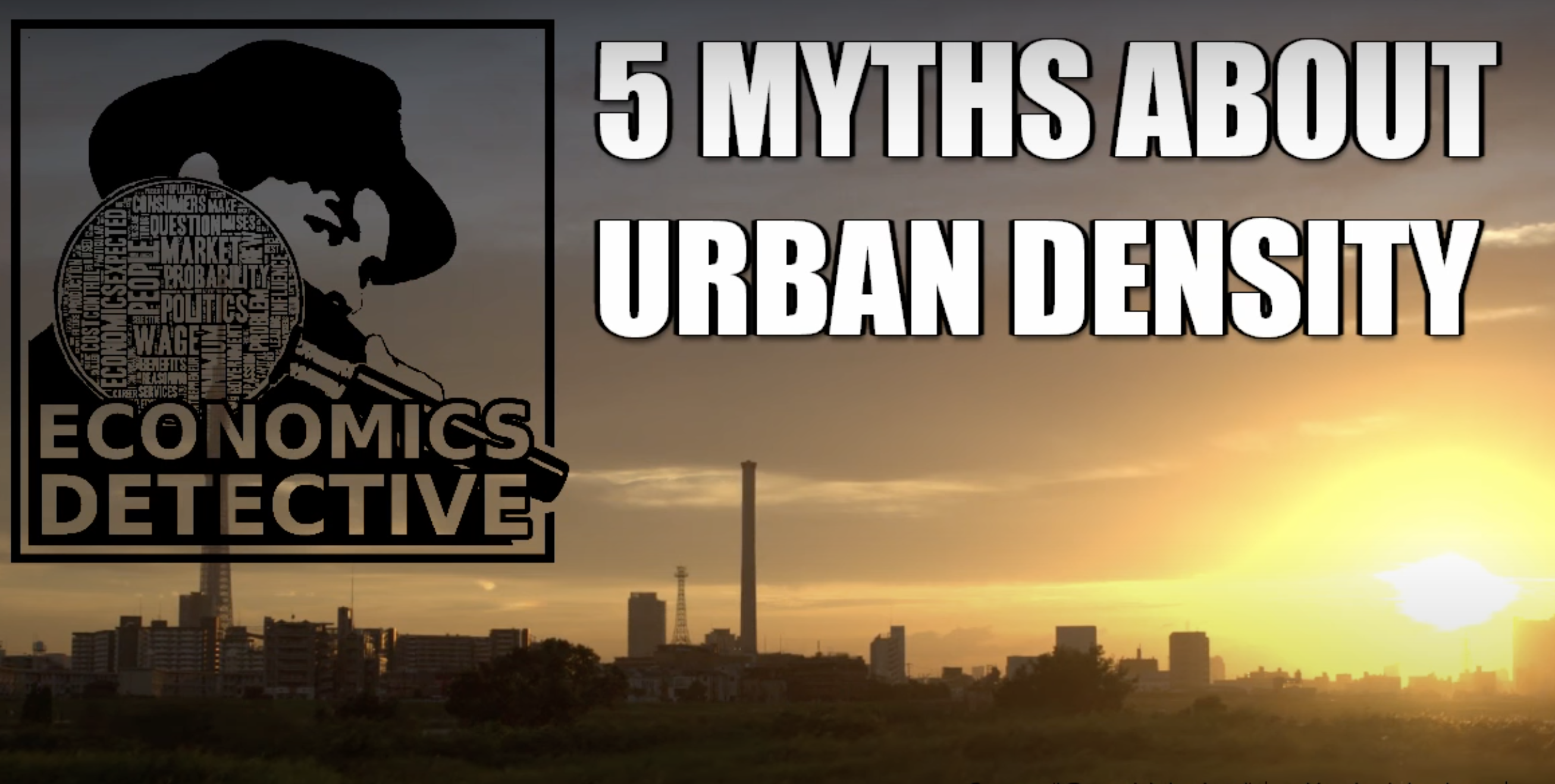
Motivation: A Scalable Educational Tool Promoting Higher Urban Density
To remediate this opposition, traditionally, urban planners would visit one community at a time, and organize public engagement events with pin-up boards, printed maps and graphic flyers to share information about proposed new development and raise the awareness about the benefits of higher density urban development through one-on-one conversation. This traditional method is not only time-consuming and inefficient (Aboelata et al., 2011), but also produces limited or uneven level of public participation since there are limited channels for local residents to express their opinions (Irvin et al., 2004). Therefore, it is imperative to foster effective public education through a scalable educational tool for people to learn about the various benefits of higher density urban development and potentially change their perception about the concept. Luckily, Human-Computer Interaction (HCI) technologies such as Augmented Reality (AR) can provide a great opportunity for educating and even persuading people to accept more higher density urban infill development projects more efficiently.
Based on a survey of existing literature, AR technologies can offer multiple advantages in educating the public about the benefits of higher density development. It can offer a more realistic feel since virtual objects are overlaid on top or within the real-world environment (Sareika & Schmalstieg, 2007). It can provide a dynamic real-time engagement with the user (Alulema, 2018) and gives an authentic common ground for constructive communication and collaboration (Goldsmith & Bousquet, 2018). Finally, it can also provide a fun and engaging experience (Mesarosova, 2014).
Therefore, the author proposes a novel tool called ARYIMBY, which reflects both its feature with Augmented Reality and its purpose of promoting more voice of “Yes in my back yard” (YIMBY) in urban development.
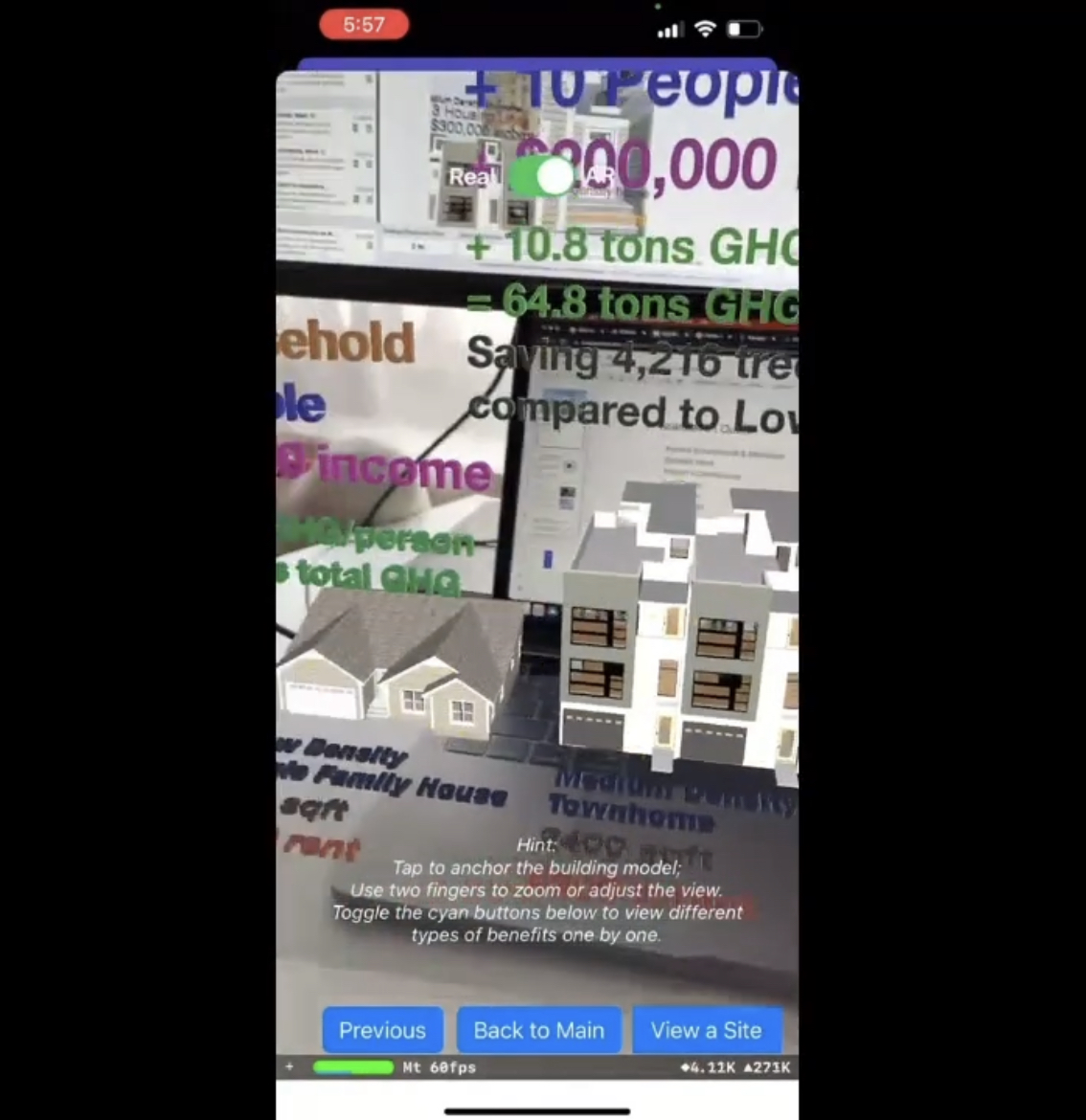
RELATED WORK
The author surveyed a wide range of visual simulation tools that are relevant to the proposed work in both academia and industry.
For example, the “Block by Block” tool developed by the UN-Habitat, Ericsson Research, and the Wits University was a successful effort in engaging hundreds of community members in a collaborative public real design exercise in Johannesburg, South Africa (UN-Habitat, 2019). Although the tool successfully raised the public’s interest of participation in the planning process, it was largely focused on visualizing public space design, thus cannot necessarily convey the benefits associated with different design alternatives. Another tool is the “CityViewAR” app developed by the University of South Australia. It allows visitors to view 3D models of original buildings in earthquake-hit areas and compare them to existing conditions in the City of Christchurch, New Zealand (Lee et al., 2012). Although it successfully conveys the impact of the disaster event, it is limited in the fact that it only provides a panoramic photolistic view of a point in time reality in the past, instead of directly integrating or juxtaposing the proposed development with the dynamic existing environment.
Another industrial tool is the “AR4Cup” app developed by Covivio for architects and urban planners to display and communicate alternative designs to various stakeholders in the design process (AR4CUP, 2019). It not only has an immersive AR viewing interface, but also provides a comprehensive scoring interface where users can rank and rate the proposed design. As shown in the following screenshots (Fig. 1), its major features include AR representation of proposed architectural design and user rating about the design.
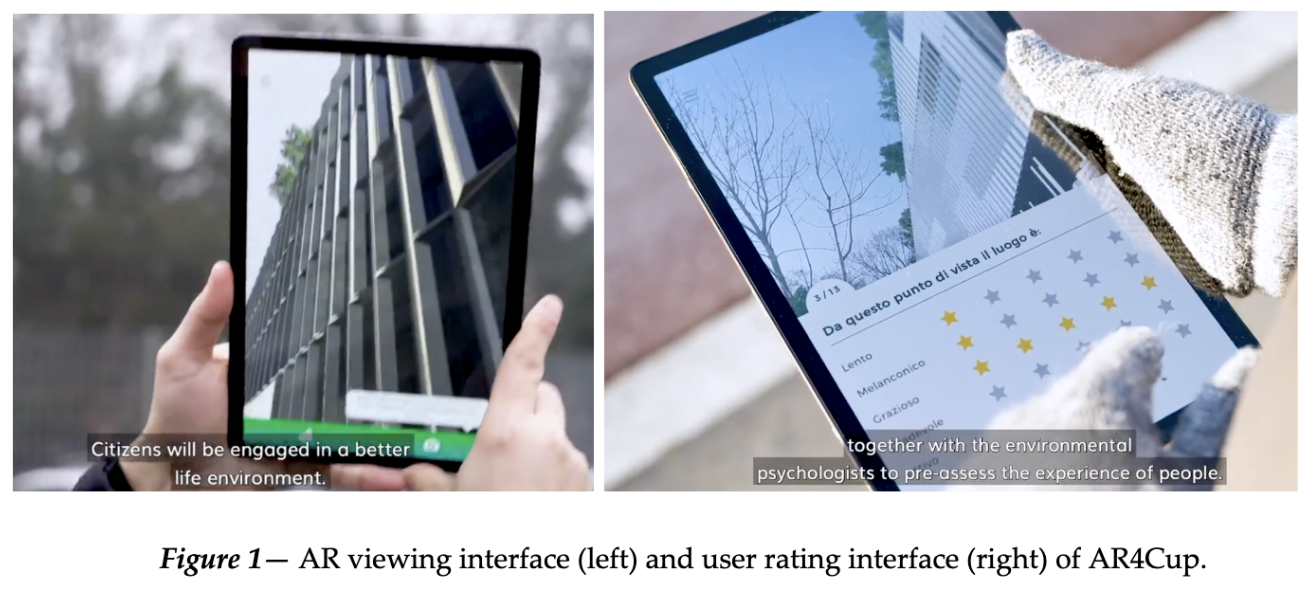
However, AR4Cup’s main limitation lies in the lack of comparisons among designs with different densities. Only a single design alternative can be presented at one time, thus users won’t be able to understand the comparative advantages of a higher density design compared to those that are lower.
Therefore, the existing tools surveyed are either lacking the necessary user interactions and feedback loops, or missing the specific focus that would meet the educational need that ARYIMBY is set to address. Their various advantages and disadvantages were evaluated and considered in the design of ARYIMBY.
METHODOLOGY
This section describes approaches applied to develop ARYIMBY and organized them into two central concepts: the Augmented Reality in Hybrid Environments and Feeback-based Learning.
Augmented Reality in Hybrid Environments
As mentioned earlier, Augmented Reality (AR) was chosen to be included due to its various strengths in interactive visualization, which provides users the capability to directly manipulate the designed scenarios and also to customize their user experiences.
Since the development and planning process is site-specific in nature, the original ARYIMBY prototype had included two modes of AR experiences, one being a generic AR experience that can happen at any location. For example, at my desktop:
at the parking lot:
Also, at the BART Station:
While the other AR session is designed for a site-specific experience that only presents the potential scenarios of different densities at a selected development site, for example, in this app, a vacant maintenance yard parcel near the Lake Merritt BART Station in Oakland, CA.
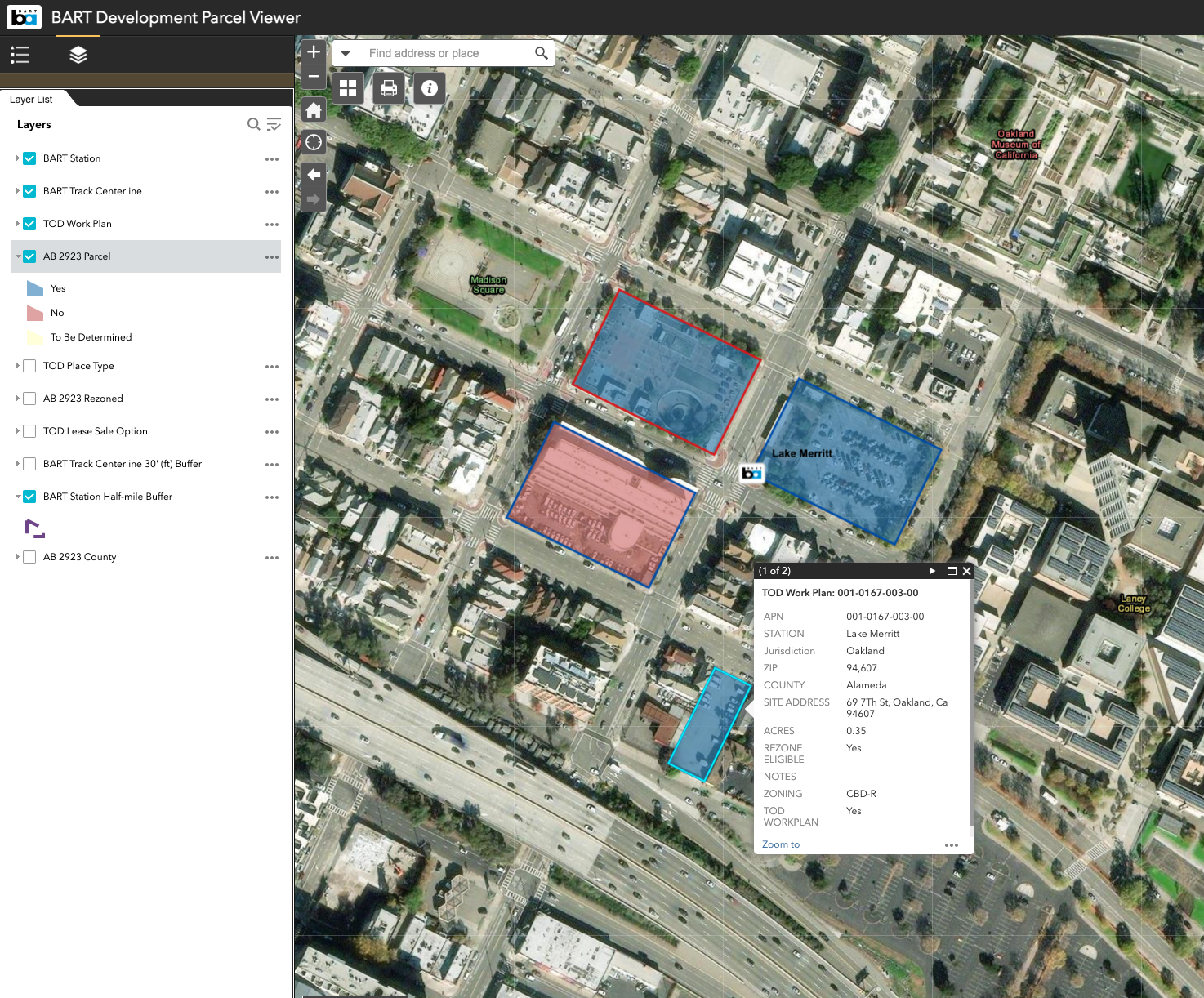
Let’s navigate to the site location from the built-in interactive map:
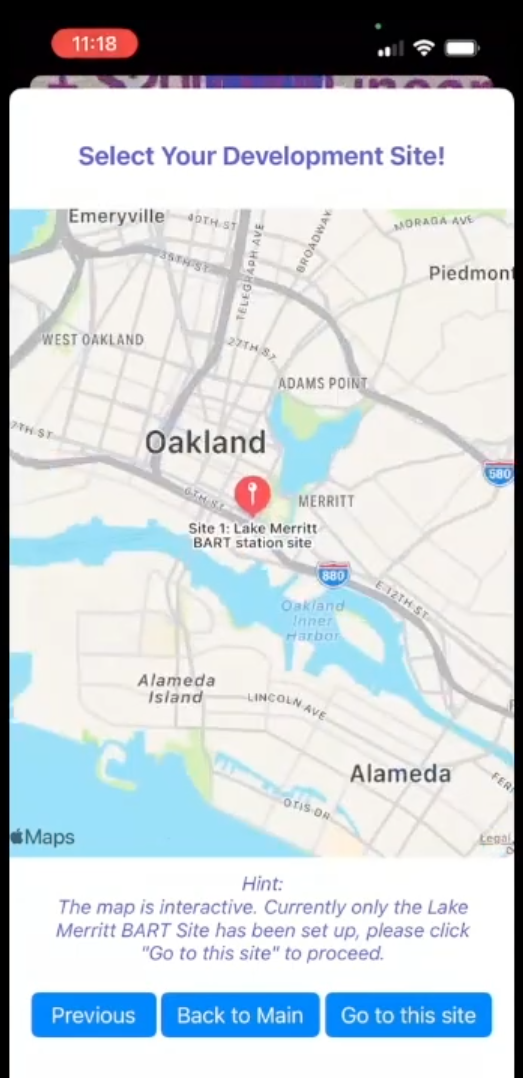
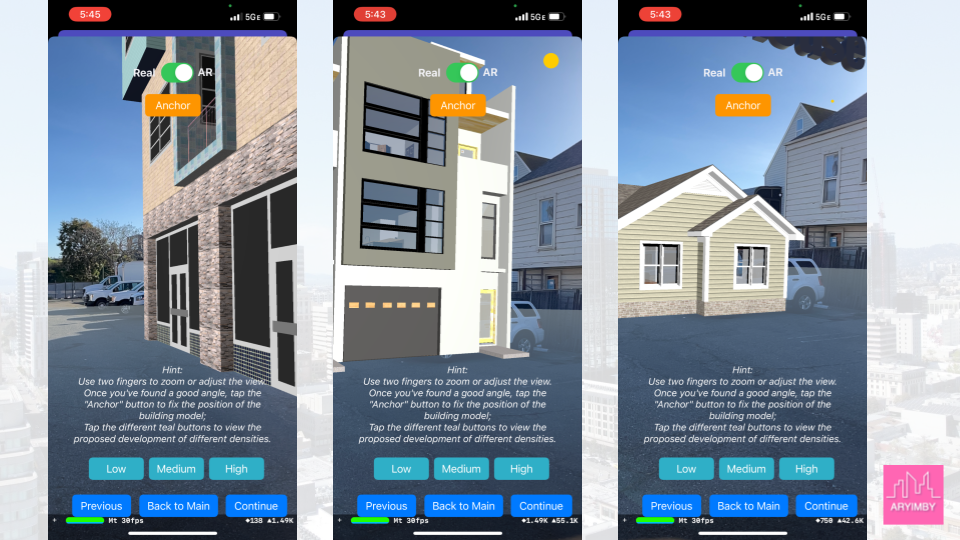
You can view it from across the street too:
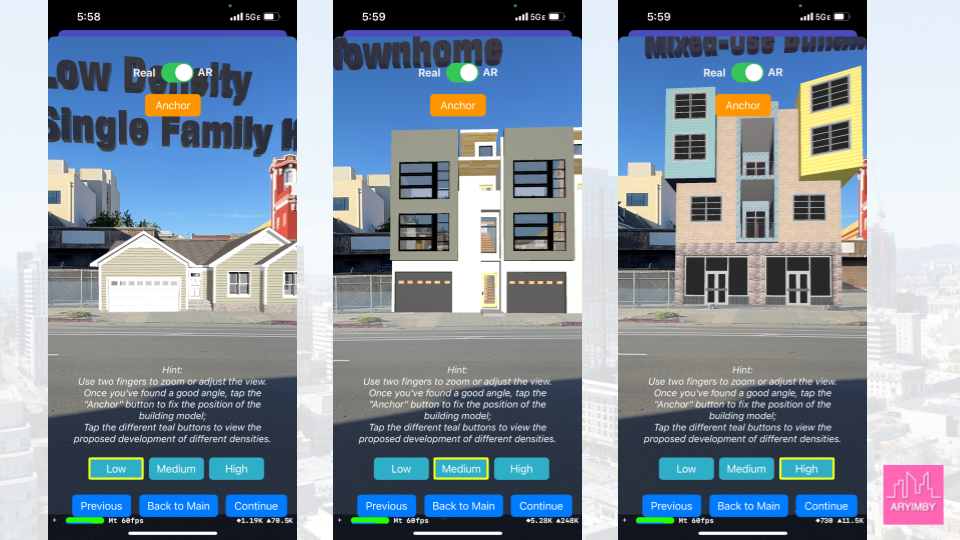
Based on some early feedbacks, instead of keeping these two AR sessions parallel, the author decided to connect the two in a sequential order, allowing the users to learn some basic concepts about differences between different densities in the generic AR session, and then selecting a development site to explore the actual benefits associated with it. By taking this hybrid approach, ARYIMBY utilizes AR’s capabilities in both visually representing different development scenarios and accurately simulating development outcomes based on real site conditions. In specific, three different AR scenes were constructed using a combination of SketchUp and Apple SceneKit, with two scenes focused on the real site AR experience. The Swift programming language was used to utilize the ARKit framework provided by Apple to develop this tool in XCode.
Feedback-based Learning
Besides technical software development, another important design methodology is feedback-based learning.
The target proposed by ARYIMBY is to change community members’ perceptions about higher density development by education, which essentially is a complex cognitive learning process. To facilitate this learning process, ARYIMBY utilizes feedback loops in not only educating users about facts, but also encouraging them to explore their own learning experience with options to customize topics and sites to look at.
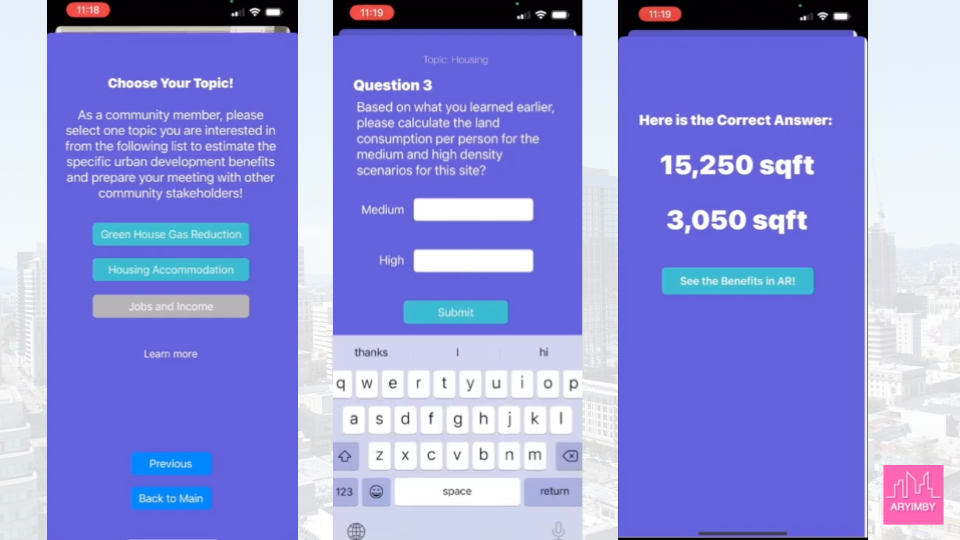
Five important characteristics of good feedbacks were considered in developing the application. In particular, it needs to be timely delivered, connected with learning outcomes, constructive, implementatble and being sensitive to individual needs. Firstly, using AR technologies provides a real time feedback to what the users are looking at compared to the real world. Secondly, the short quiz game section directly connects to the expected learning outcome, and gives feedbacks to whether the user’s reasoning is reflecting what they learned in earlier sessions. Thirdly, the app uses languages that are constructive and encouraging to help users navigate through the steps. Then, by providing accurate models of proposed development, ARYIMBY offers an opportunity to authentically evaluate the development impacts against real world. Finally, even though only one out of three proposed sites was prepared due to time constraints, the inclusion of custom site and benefits topic selection allows users to explore their own interests within the app.
RESULTS
In this section, the deployed ARYIMBY v1.0 application will be presented first, followed by a discussion of product evaluations conducted throughout the development process, which consists of both an early phase wireframe evaluation and a beta-testing evaluation.
The ARYIMBY UX Design
The ARYIMBY app was made available to 20+ beta-testers via TestFlight, Apple’s iOS app beta-testing platform. The project itself, with the development code, assets and materials used, and documentations can be accessed via Github: https://github.com/wenhaowuuu/ARYIMBY. The final application front-end is presented below as a storyboard (Fig. 2) with multiple screens of activities and interntconnected user interactions.
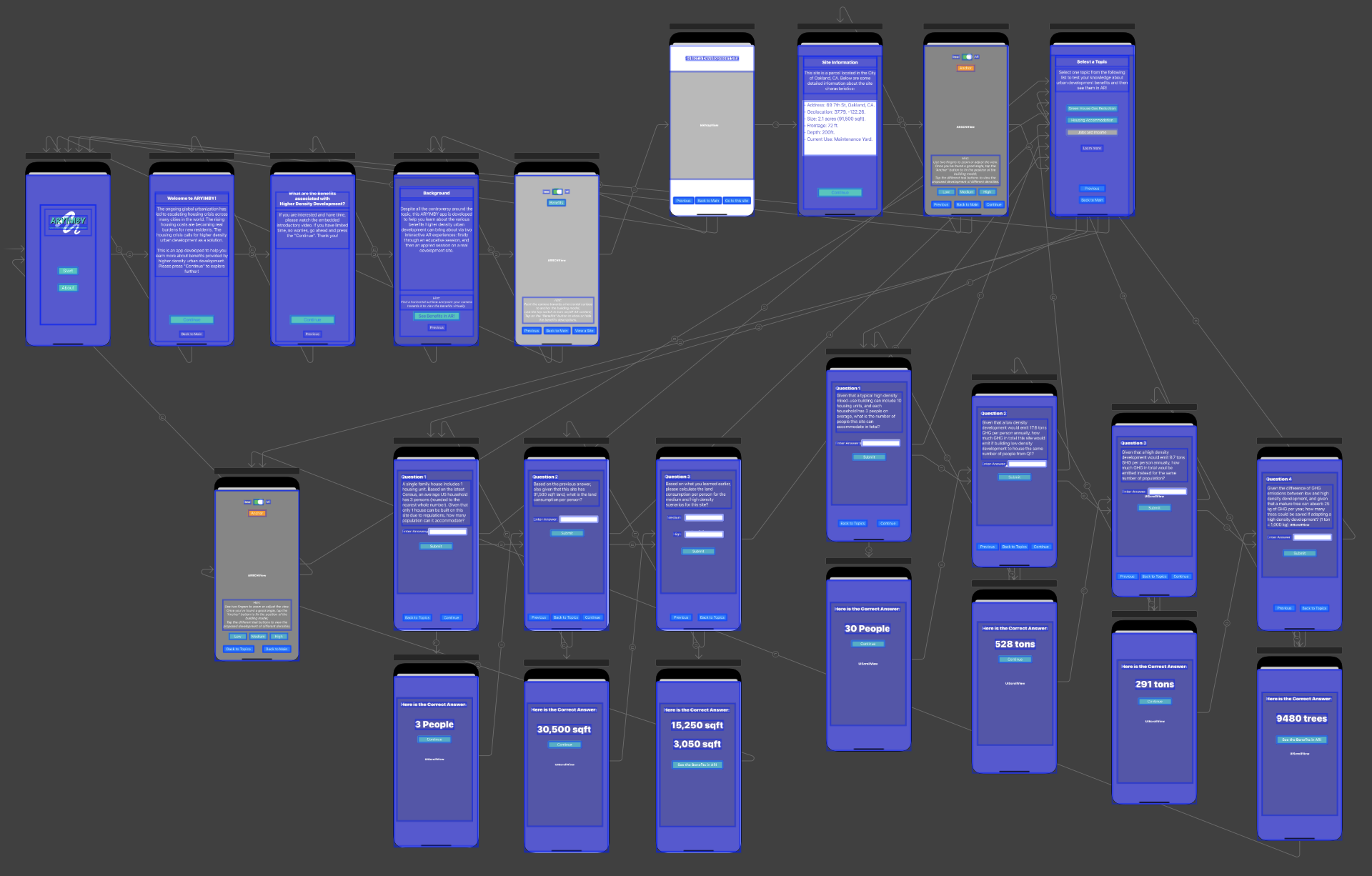 The app first introduces the user to the app, and then provides users with three different educational AR sessions, interconnected by customizable site and topic selections based on users’ interests and preferences. The detailed activities and designed user interactions are summarized in the table below:
The app first introduces the user to the app, and then provides users with three different educational AR sessions, interconnected by customizable site and topic selections based on users’ interests and preferences. The detailed activities and designed user interactions are summarized in the table below:
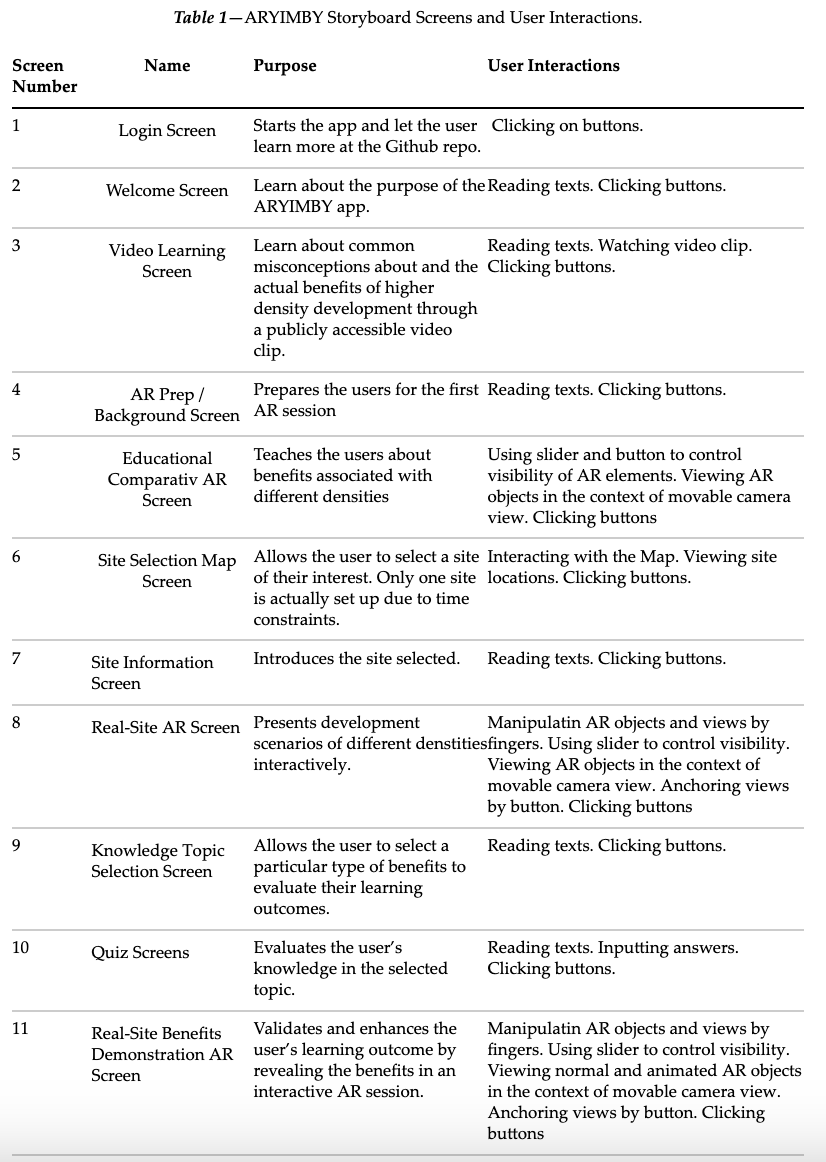
App Demo
View the final app demo here
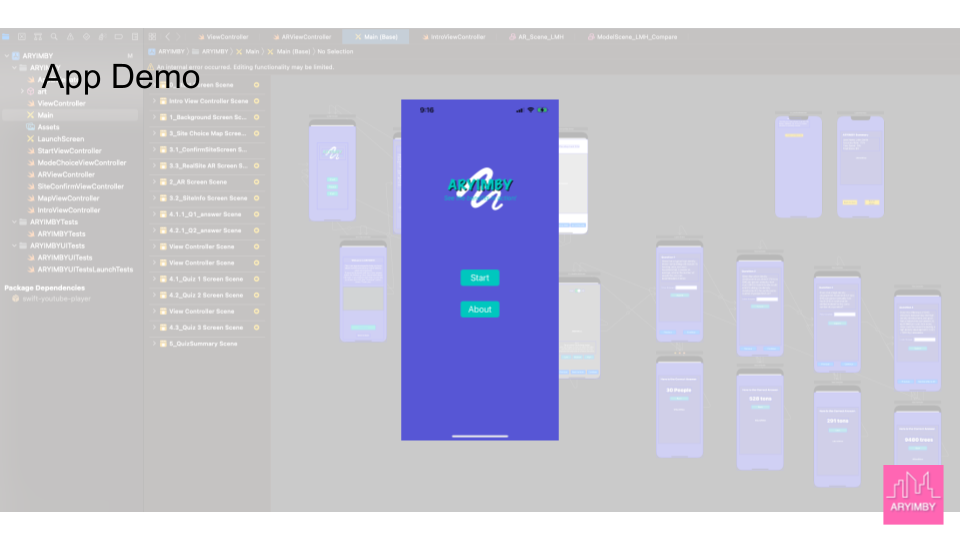
App Evaluation
Two product evaluations were implemented across the phase of ARYIMBY development. In total, 52 participants were invited to the evaluations and gave feedbacks to the product. The evaluations were mainly conducted via online surveys and several informal conversational interviews. The surveys conducted are the Wireframe Survey and the Beta-testing Survey.
Some of the survey results are summarized below.
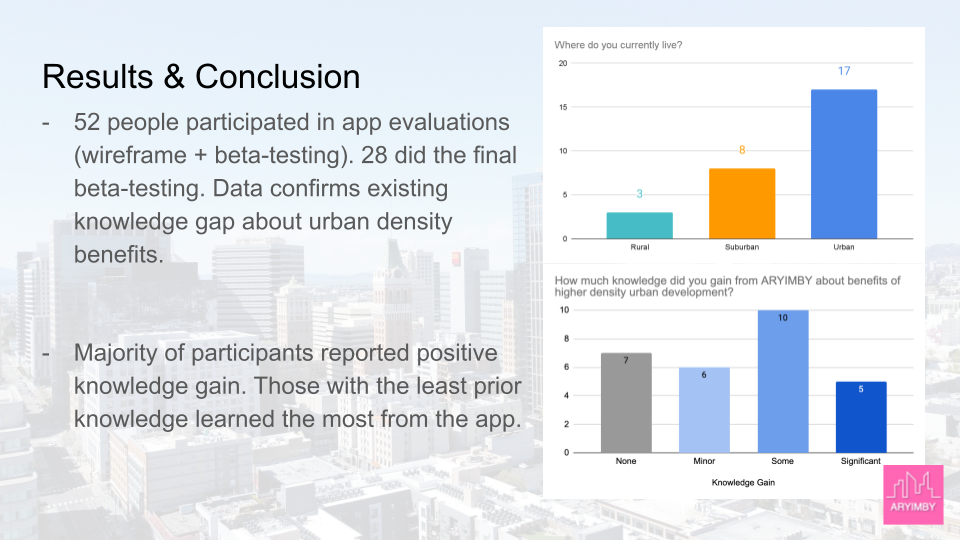
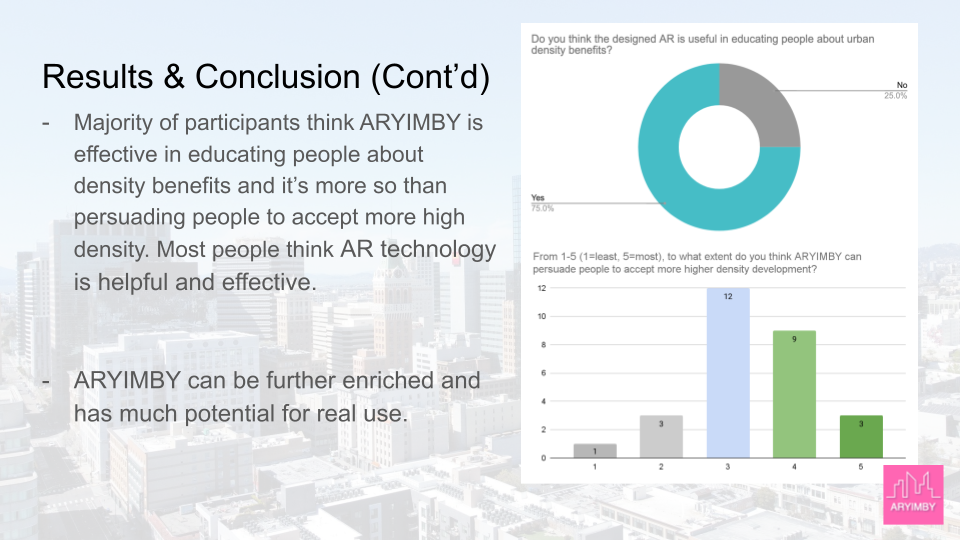
Wireframe Evaluation
In total, 24 people responded in the wireframe survey (see appendix) during the initial phase of development. The wireframe survey focused on understanding how much knowledge potential users have about urban development benefits and also evaluating whether the components envisioned in the wireframe prototype are useful to educate people.
In the response, 62.5% (15) of the respondents have less-than-average knowledge level on the topic of higher density urban development, while nearly 30% reported having above-average knowledge level. This somewhat represents the actual knowledge situation of average community members in a generic urban development scenario.
Among those reported having no to limited knowledge on the topic, 100% reported thinking that the proposed wireframe was easy to understand and follow, indicating a successful design in terms of small gulf of execution. 73.3% of them reported that the proposed wireframe would be effective to educate people of higher density urban developments. 73.3% of them also thought the proposed AR sessions would be useful. 93.3% of them thought that the included quizzes would be useful helping users to learn. These results confirmed that the prototype design was on the right direction.
Aside from the quantitative analysis above, the respondents also provided some helpful qualitative feedbacks, such as reporting difficulties on readability and clarity on some screens, desired interactions, better integration between components, etc. These feedbacks were gathered and integrated into the actual product development of ARYIMBY, and refinements and adjustments were made iteratively throughout the process.
Beta-testing Evaluation
Upon finalization of the ARYIMBY v1.0 application, it was deployed on Apple Store Connect and was made available for beta-testing via TestFlight. Besides this, the author also created a survey with an app presentation to collect feedbacks. The evaluation participants have options to either only watch the app presentation or actually installing and testing the app on their own devices, or doing both if they are interested.
The feedback survey collected 28 responses in total. Among them, 90% are between the age of 18-39, which is the age group when people are starting to settle down with families. 61% of them live in an urban environment, and 29% live in the suburbs, followed by 10% living in rural areas, which indicates diverse backgrounds of the participants. Interestingly, nearly two thirds of people (64%) with very limited prior knowledge about the topic actually live in an urban environment, which indicates an existing knowledge gap among urban residents about higher density development benefits. It also indicates the potential to raise public awareness in existing urban communities.
In terms of feedbacks about ARYIMBY’s effectiveness, the attitudes vary across respondents. 75% of respondents reported positive knowledge gains from using the app, and 54% of them reported a more-than-minor extent. Overall, 50% of respondents reported below-average level prior knowledge on this topic, which again indicates potential to raise awareness. 39% of respondents have none to very limited knowledge, and all of them reported some positive knowledge gain, and about half of those reported a significant knowledge gain (>= 3 on the scale of 1-5). This is an encouraging result. Actually, there are many open-ended comments stating that they learned something very different from their original conception about higer density development. Some are quoted here:
“I didn’t know it was so helpful for the planet.”
“I never thought about the environmental impact of housing.”
“I was surprised how much land single-family residential took up, especially compared to HD resindential.”
“…surprised to learn that the stats in terms of how many more trees are saved is exponentially higher than that compared to lower density development…”
This is exactly what the app is trying to achieve, which is raising the awareness of higher density development benefits among general community members.
In addition, 61% of respondents thought that ARYIMBY was effective overall in educating people about benefits of higher density urban development, while 36% reported neutrally. 43% of them thought that ARYIMBY was effective overall in persuading people to accept more higher density developments. This is not surprising, as it’s often more difficult to change people’s attitudes and behaviors than teaching them new knowledge.
In summary, based on the evaluations and feedbacks, ARYIMBY has generally achieved its envisioned goal as a successful proof–of-concept application. Although there are much work to be done in further improvements and testing, it provides much potential to be used as a public education and outreach tool in promoting higher density urban development, and thus contributing to remediating housing crises in a scalable manner.
CONCLUSION
As a proof-of-concept, ARYIMBY was able to verify that it is a helpful tool to educate users, especially those with limited knowledge on the topic, about benefits of higher density urban development. However, given its limited functionality and simplified content at this point, it is hard to say that it can persuade people to accept more higher density developments, especially with so many external societal factors at play beyond just a single application.
Nevertheless, it was encouraging to see this app taking shape from a wild imagination to a wireframe prototype, and then to a functional app and now being tested by others beyond the author. The needs have been identified, technologies are in place, and the development workflow was well explored. The author is excited about the potential of this app being used in real-world urban planning efforts to promote a more sustainable urban future.
